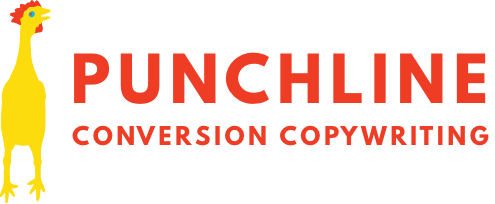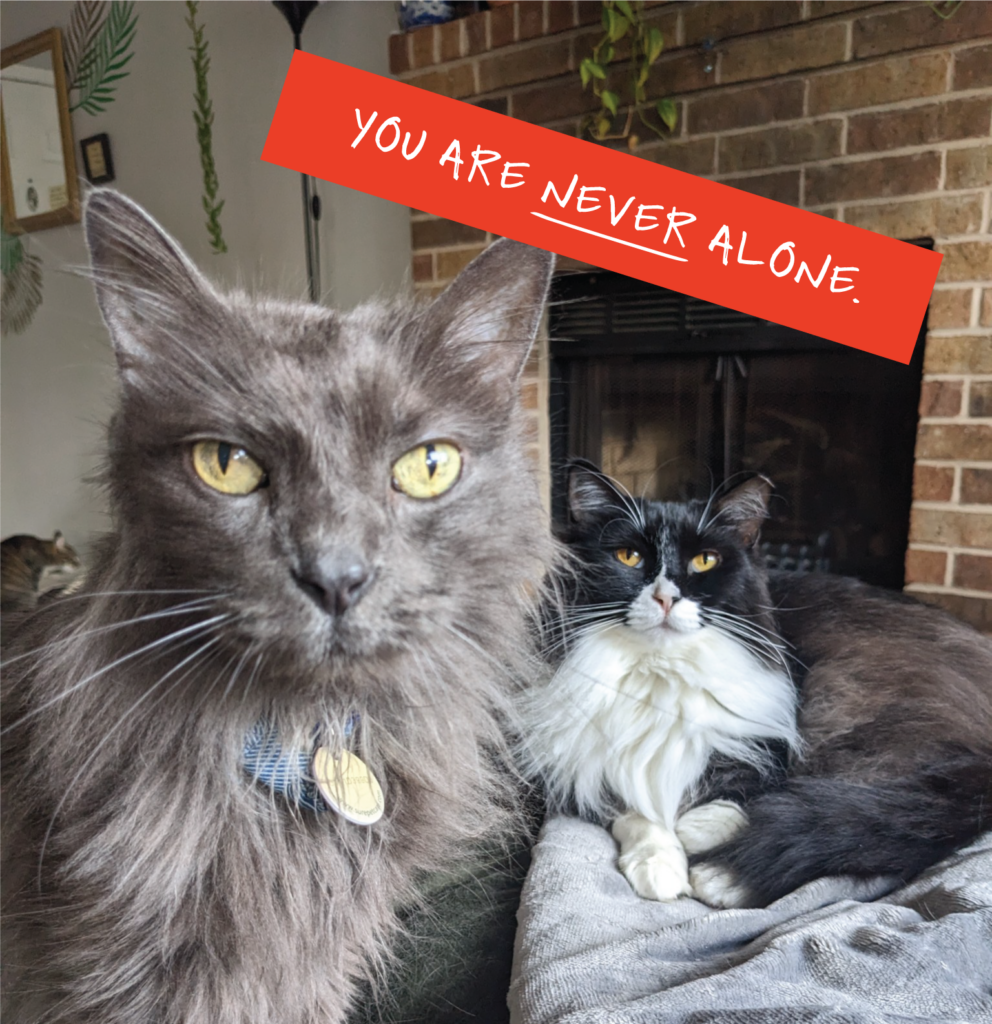We all have THAT friend.
The one who effortlessly charms new pals the moment they meet her.
Who cracks jokes that make everyone laugh. Who makes you feel like you’re part of a secret club just for knowing her.
She’s radiant, game for anything, and also happens to be a great cook and did we mention she’s not only super-organized, but DROP-DEAD GORGEOUS?

Seriously, fuck her.
You probably secretly resent that friend.
You think, “I’ll never come off that way. She’s just got something I don’t.”
And it can be tempting to think the same thing about your marketing copy. You’ve probably had at least one day where you slammed your laptop closed, huffed like the Big Bad Wolf, and said,
“Fuck it. I can’t write engaging, funny, warm copy. It just doesn’t come naturally to me.”
Why would you even WANT to write funny?
Maybe you want your writing to be funnier because you know that humor is a shortcut to the Holy Grail of marketing: trust.
Maybe you’re just trying to mix it up a little bit, because you’re tired of sounding like every other ho-hum copywriter or content creator out there.
But the idea of being funnier is hard for people who don’t feel a constant need for validation like they’re naturally funny.
And “be funny” is not an actionable piece of advice.
Luckily, even if you’re as uptight as Anna Wintour in a whalebone corset, you can still come off as fun, warm, and personable in your copy.
You just need a little guidance. Sentence-level hacks.
And that, my sweet little toaster pastry, is what I’m here to give you.
How to fake being funny on paper
Here’s a little secret that I’ve only shared with my cats: You can write like you normally do, and then go back and edit in humor and personality.
*record scratch* Wiggity wiggity whaaat? YES. IT IS POSSIBLE.
Small, sentence-level changes to your writing can add up to a totally new voice. Then you can take full advantage of humor’s effects on your audience.
Here’s how this will go: I’ll show you 10 sentence-level punchup techniques I personally use, explain WHY I use them, and tell you WHEN it’s appropriate (and not) to use each technique in your copy.
Two caveats before we dive in:
![]() Know your audience. Don’t go whole-hog with humor and then discover your market is actually comprised of 100% tired, angry high-school principals.
Know your audience. Don’t go whole-hog with humor and then discover your market is actually comprised of 100% tired, angry high-school principals.
![]() Prepare to chill out. These techniques require a little laxity with syntax, punctuation, all that good nerdy stuff. So this approach probably won’t appeal to strict grammarians. (But honestly, I used to BE a grammarian — and then I loosened up. I feel better now.) 😉
Prepare to chill out. These techniques require a little laxity with syntax, punctuation, all that good nerdy stuff. So this approach probably won’t appeal to strict grammarians. (But honestly, I used to BE a grammarian — and then I loosened up. I feel better now.) 😉

Punchup #1: Write words in ALL CAPS
You wouldn’t deliver a speech in a flat monotone at a steady volume, right? You’d find a dynamic range between soft and loud, high-pitched and low.
You can do the same by working caps into your writing here and there.
On most of the internet, writing in all caps indicates yelling or emphasis.
So anywhere you’re feeling ferocious in your copy, write a couple of those words in caps! DO IT! TRY IT AT LEAST ONCE!
See what I did there?Tip: Anywhere you decide to use all caps, use them judiciously. I like to avoid capitalizing whole sentences, and stick to a few key words.
Like I did with this subject line in an email to my list, which got a 66.2% open rate:

I am fairly screamy, yes.
Best place to use CAPS: Emails (both subject lines and body copy), personal social media, anywhere that feels like a one-on-one connection.
Worst place to use CAPS: New client proposals (YMMV). Also SMS or MMS marketing messages — since those are usually already too close to feeling spammy and invasive.
Punchup #2: Punctuate “incorrectly” or include a typo (pick one)
Yes, this copywriter is telling you to intentionally make “mistakes”.
Because mistakes are inextricably woven into the way people communicate, they help you appear more human, and thus more trustworthy.
In certain contexts, they also help you appear like you just dashed off your latest marketing message, then sashayed away into the sunset — instead of what actually happened (AKA you hunched over that marketing message way ahead of time. Wrote it. Revised it. Scheduled it).
One of my personal favorite ways to punctuate “incorrectly”? Asterisks.

Plus, language is fluid. Keeping current with how the youth are currently punctuating helps you look more like a culturally knowledgeable, likeable Young than a stodgy, irritable Old.
Here’s Mark Littlewood of Business of Software flaunting his hipness in an intentionally misspelled subject line:

Now, I don’t advocate intentional typos more than once every EXTREMELY blue moon, because you have to demonstrate competence, too.
One study found that typos in email body copy amplified the perceived emotion of that body copy — so angry emails came across as angrier, and happy emails came across as even more joyful.
However, the same study also found that while typos make you seem authentic (duh), they also decrease the perception of your intelligence (double duh).
And while I’ve personally had success with lowercased (AKA “incorrect”) subject lines, and Joanna Wiebe of Copy Hackers and Airstory has experimented with them, Boomerang notes that emails with a lowercase subject line receive 13% fewer responses.
So consider whether you’re looking for responses or opens, and tread carefully.
Best place to punctuate incorrectly: Tweets, blog posts, and emails
Worst place to punctuate incorrectly: One-on-one emails and when you need to make a sale
Best place to try a small typo: Email subject line (It might actually boost your open rates)
Worst place to try a small typo: Everywhere else.
Punchup #3: Contract words and throw in some abbrevs 😉
Contractions and abbreviations work on the same principle as mistakes, above.
Contractions show that you speak informally, while abbreviations signal to your audience that you just can’t wait to get to the point.
Both position you as a casual person. And both subtly show that you feel comfortable treating readers as friends.
Here’s ConversionXL’s Alex Birkett titling a blog with an abbreviated swearword (BS):

Best place to use contractions: Everywhere. It’s 2019.
Worst place to use contractions: Your mom.
Best place to use abbreviations: With any word that is commonly abbreviated and whose abbreviation is widely recognized, ex. “Favorite” to “Fave” or “You” to “U”. Social media is particularly suited to abbreviations.
Worst place to use abbreviations: New client proposals, and on any word your audience won’t recognize in its abbreviated form.
Punchup #4: Chop up your sentences
Ah, sentence fragments. The bane of every grammar teacher’s existence.
(I just fragmented the sentence above. To show you what I mean. Which you totally get, right?)
Cutting sentences down so they start with words like “And,” “Because,” “But” and “Which” may not be grammatically correct, but it’s the way we talk.
It imitates the cadence of casual conversation.

Headspace knows how to chat.
Plus, it’s WAY easier to parse short sentences than those with tons of dependent clauses.
Give each sentence one job. Or half of one. 😉
Best place to start sentences in the middle: Try this in emails and landing pages. Anywhere you need a conversational tone without sacrificing clarity.
Worst place to start sentences in the middle: More formally written copy and content, like white papers.
Punchup #5: Ask + answer questions
Asking questions and then immediately answering them in your copy helps you accomplish two goals:
- It helps keep you from overlooking anything your reader might be wondering about
- It creates a conversational flow and helps you draw more attention where you need it
For example, have you noticed that I’ve been using this technique throughout this post? Yes. Yes you have.
NOTA BENE: This technique isn’t the same as asking a rhetorical question, where the answer is already assumed or known, and not usually expected.

Image via GoodLandingPages.com.
Best place to ask + answer your own questions: Landing pages.
Why? Because when you write this way, it’s much easier to get into your prospect’s head and mirror the same flow of questions they’re feeling. You’ll end up with a more persuasive page.
Worst place to ask + answer your own questions: There’s no real “worst” place for this. But don’t get too caught up in it. Why? Because it starts to get annoying. What do I mean? Exactly.
Punchup #6: Choose comic book words
One of the easiest ways to take copy from “fine” to “fantastic” is through specific word choice. Lots of writers know that.
So it follows that the way to take copy from “fantastic” to “fantastically funny” is to choose funny or outlandish words. I like to call ‘em “comic book words”.
Words for fighting moves are excellent replacements for boring verbs in your calls to action (like “submit,” “subscribe,” etc).
For example:
“Send my ebook now” could become “Dropkick that ebook into my inbox”
Some comic book words are onomatopoeia (words that spell out noises), like “splat” or “meow”. These work well to stimulate the reader’s imagination when sprinkled in throughout, usually formatted in italics.
Here are a few of my favorite comic book words and onomatopoeia (sorry they’re so violent):
- Dropkick
- Bam
- Punch
- Kaboom
- Splat
- Shazaam
Best place to choose comic book words: Anywhere you need to illustrate a sensation, or you want to make a visceral connection. Also, whenever you want a stickier call-to-action verb.
Worst place to choose comic book words: Anywhere you run the risk of obscuring your own meaning or distracting from your point.
Punchup #7: Throw in puns and portmanteaux
Now, this right here is the type of humor that most people have in mind when they say “I’m not funny.”
The truth is that anyone can come up with puns.
And anyone can come up with portmanteaux — you know, the thing where you squish two words into one, like “bran” and “banana” into “branana,” which sounds like a horrible new protein bar.
It’s a mental muscle, and it gets stronger with exercise.

This is masterful. Shared by @exclaimeditor on Twitter.
Want to get started working out your pun muscles? Next time you think of a dad joke, MAKE IT. Out loud. Then revel in the groans.
Best place to make a pun: Emails, un-promoted social media posts. Basically anywhere you’re not gunning for a conversion.
Worst place to make a pun: I’ll let you know when I find it. (But really: CTA copy. Don’t sacrifice clarity for a joke.)
Punchup #8: Give asides in parentheticals, italics, or quote marks
Writing an aside is the equivalent of actors breaking the fourth wall in a movie or TV show.
You can crack a joke, spell out what you’re thinking or what the reader is thinking, or hold imaginary debates.
Kira Hug and Rob Marsh pretend to know what readers are thinking re: fingers in this subhead from their Copywriter Accelerator sales page:

And Cate Martel does something similar in this email from The Hill, using parentheticals to address reader objections (or pretend reader objections):

Asides immediately make your writing more lively. They can also make the reader feel like they’re in on a secret.
Best place to include asides: Try this in content pieces and emails. But, as with most of these tips, beware including too many. You’ll frustrate readers who just want you to get to the point. (I’ve been there.)
Worst place to include asides: Calls to action.
Punchup #9: Trail off with ellipses
Would you believe…
That trailing off with an ellipsis (or as some people call them, “tri-periods”) adds drama and anticipation to your copy?
Playing with punctuation allows you to dictate where your reader will pause, so you can create an intentional cadence.

Crosshead ellipsis example via GoodLandingPages.com.
Also, lines ending in ellipses are often shorter, which makes them a breath of fresh air for a visually fatigued reader.
Best place to trail off with an ellipsis: Email subject lines (hello, curiosity gap!). Email body copy, whenever a shorter line would push your reader to keep going. Landing pages, when you’re agitating a problem.
Worst place to trail off with an ellipsis: Marriage proposals.
Punchup #10: “Misspeak” using strikethrough
This is one of my favorite techniques, and you’ve probably definitely already noticed it in this post.
I like strikethrough because it harks to actual writing — like, in a notebook with a pen. (FYI, a pen is a hollow tube filled with dark liquid that you use to make marks.)
It’s a fun way to make a joke in just a couple of words without distracting the reader.
Also, not every reader will notice struck-through copy — so it’s a subtle reward for those who are paying attention.
Best place to use strikethrough: Anywhere you want to make a joke, but don’t want to spend more than a couple words on it.
Worst place to use strikethrough: UVPs, headlines, and anywhere else clarity is paramount.
BONUS Punchup #11: Include emoji and GIFs
I saved the best for last!
Along with breaking up copy to save readers from visual fatigue, GIFs can take your jokes to a new place. They help illustrate concepts succinctly — and obviously, they’re entertaining!

Sometimes, GIFs can even inspire the perfect frame for an entire piece of content or copy, like when I discovered there were enough Matrix GIFs to illustrate a 2500-word piece on evoking emotion in ecommerce copy.
Best place to use GIFs: EVERYWHERE. (Really: content pieces, emails, social media. And specifically in content pieces when you know it’s time for an image, but there’s no graphic or photo that can help illustrate the point you’re making.)
Worst place to use GIFs: I… I do not know. They are perfect.
See these techniques in action
Wanna see how I apply these tips? Let’s do it live.
Here’s a paragraph I swiped from an email I got the other day.
Example 1 original copy
Stop charging by the hour.
Here’s why:
If you’re charging hourly prices for the work you’re doing for clients, you’re putting a cap on your earnings, you’re doing your clients a disservice, and you’re building the wrong kind of career.
When you bill hourly, you are putting yourself in a position where you are incentivized to take as long as possible to deliver the results that your client is trying to buy.
After all, why would you spend any time or energy trying to figure out how you could fulfill this contract in half the time, thereby cutting your pay in half?
So it’s not so much that you will intentionally ignore ways to optimize the process, but that you won’t be harnessing your mind in that direction.
Now, this copy is solid. It makes sense. But it’s a snoozefest, personality-wise.
To punch it up, I’d pick and choose from the techniques above, and…tada:
Example 1 revised copy
HOLD UP. Stop charging by the hour.
Just stop. Right now.
Why?
If you’re charging hourly prices for the work you’re doing for clients, you’re putting a cap on your earnings (and not the cute kind of cap, like a baby would wear to a ballgame).
You’re doing your clients a disservice, and you’re building the wrong kind of career. Sorry to break the bad news there, guy.
When you bill hourly, you put yourself in a position where taking as long as possible to deliver results = rewarding yourself for inefficiency with a big fat cookie, I mean paycheck.
Which means you probs won’t spend any time or energy trying to figure out how you could fulfill this contract in half the time. Since that would slash your pay in half.
So you won’t intentionally IGNORE ways to optimize the process, but you def won’t be focusing on getting harder, better, faster, stronger.
Punchup techniques I used
- All caps
- Asides (italics and parentheticals)
- Abbreviations
- Asking and answering questions
Want another example? Here’s part of a landing page I punched up for leadPops.
Example 2 original copy
I can’t count how many clients I’ve worked with who are paying all kinds of money to generate leads…
Only to have those leads “fall through the cracks” because it’s such a headache to transfer the leads into the LO’s email newsletter software for consistent, regular follow-up.
In fact, many mortgage companies could grow their current business by 75-100% or more just by plugging this one leak.
Sprinkle with magic sauce, aaaannnnd 3, 2, 1…
Example 2 revised copy
What kind of cash would you let slip through the couch cushions?
Pennies? Dimes?
How about quarters?
How about $100 bills?
Crisp Benjamins, just slipping down into No-Man’s Land, because you’ll never remember to check under there…
If you’re paying tons of money to generate leads…
Only to watch ‘em fall through the cracks because it’s such a headache to transfer their information into your email software…
You might as well be emptying your pockets into the couch, my friend.
Many mortgage companies could grow their current business by 75-100% or more just by plugging this one leak.
Punchup techniques I used
- Asking and answering questions
- Asides (italics)
- Abbreviations
- GIFs
Use this knowledge wisely, padawan
All right. Now you know all most of my secrets.
You’re poised to become the friend everyone talks about…
So one last thing: Don’t go crazy with these tips.
Pick the techniques that feel easiest or within reach for you. Then try them in a low-pressure situation (like an unpromoted social media post, non-sales-related email to your list, or best yet: in a post on your own blog).
Then sit back and see what happens! In my experience, people will perk up and take notice.
And whether they like your new style or not, they’ll tell you what they think — which is better than crickets any day.








2 Comments
-

Pingback Not a Newsletter: July 2023 | Inbox Collective